The Machine Vision Camera Market is estimated to be valued at USD 4.2 billion in 2025 and is projected to reach USD 9.2 billion by 2035, registering a compound annual growth rate (CAGR) of 8.3% over the forecast period.
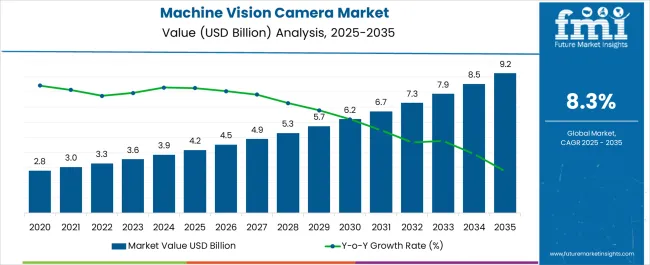
| Metric | Value |
|---|---|
| Machine Vision Camera Market Estimated Value in (2025 E) | USD 4.2 billion |
| Machine Vision Camera Market Forecast Value in (2035 F) | USD 9.2 billion |
| Forecast CAGR (2025 to 2035) | 8.3% |
The Machine Vision Camera market is experiencing robust growth driven by rising automation across manufacturing, automotive, electronics, and logistics industries. The current market scenario reflects an increasing preference for cameras that combine high-resolution imaging with advanced software analytics, enabling precise inspection, measurement, and quality control. Growth has been supported by the integration of intelligent vision systems into production lines and robotic platforms, enhancing productivity and reducing operational errors.
Additionally, the demand for real-time monitoring and predictive maintenance has accelerated adoption of machine vision solutions across end-use industries. Technological advancements, including improved sensor performance, faster processing capabilities, and scalable deployment options, are shaping the future of this market.
The expanding use of automated guided vehicles, AI-based defect detection, and assembly line monitoring continues to create opportunities for high-precision imaging solutions As manufacturers increasingly prioritize operational efficiency and quality assurance, the machine vision camera market is poised for sustained growth in both developed and emerging regions.
The machine vision camera market is segmented by type, function, end user, and geographic regions. By type, machine vision camera market is divided into CMOS Sensor-Based Cameras and CCD Sensor-Based Cameras. In terms of function, machine vision camera market is classified into Area Scan Cameras, 3D Cameras, and Line Scan Cameras. Based on end user, machine vision camera market is segmented into Automotive, Pharmaceutical & Healthcare, Food And Beverages, Electronics & Semiconductors, Packaging, Process Control, Printing & Labeling, and Others. Regionally, the machine vision camera industry is classified into North America, Latin America, Western Europe, Eastern Europe, Balkan & Baltic Countries, Russia & Belarus, Central Asia, East Asia, South Asia & Pacific, and the Middle East & Africa.
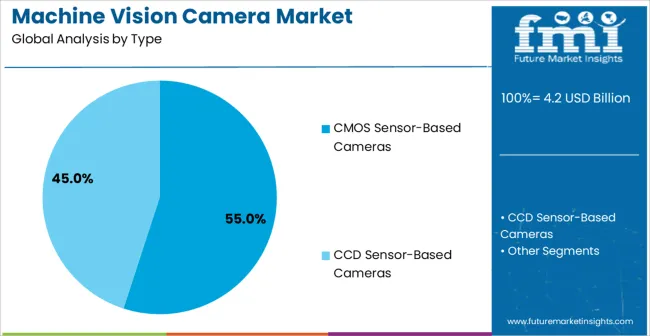
The CMOS Sensor-Based Cameras segment is projected to hold 55.00% of the Machine Vision Camera market revenue in 2025, making it the leading camera type. This dominance is being attributed to the high-speed performance, low power consumption, and excellent image quality offered by CMOS technology. Adoption has been driven by applications requiring rapid image capture, such as automated inspection, robotics, and high-throughput manufacturing environments.
The modular nature of CMOS-based cameras allows for integration with advanced image processing and AI-driven analytics without significant hardware changes. The growth of this segment has been reinforced by improvements in sensor sensitivity, resolution, and dynamic range, which enhance accuracy in complex industrial settings.
Additionally, CMOS cameras offer a favorable cost-performance ratio, making them suitable for large-scale deployments in diverse industrial applications As manufacturing operations continue to evolve toward smart factory models, the CMOS Sensor-Based Cameras segment is expected to maintain its leading position due to its adaptability, efficiency, and compatibility with next-generation machine vision software.
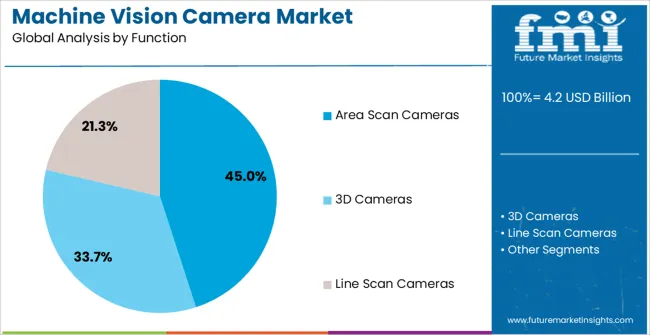
The Area Scan Cameras segment is expected to account for 45.00% of the Machine Vision Camera market revenue in 2025, making it the dominant function type. This leadership has been influenced by the capability of area scan cameras to capture full-frame images in a single shot, ensuring high precision in inspection and measurement tasks. Adoption has been particularly strong in industries that require detailed image analysis, such as electronics assembly, packaging, and quality control processes.
Growth has been further driven by integration with software-defined imaging systems, which allow rapid processing of high-resolution images and advanced defect detection. The flexibility to deploy these cameras across different production lines without physical redesign has enhanced their attractiveness.
With the increasing demand for automation and stringent quality standards across industries, the Area Scan Cameras segment is anticipated to continue leading the market Its ability to deliver accurate, reliable, and efficient imaging solutions has positioned it as a preferred choice for end users seeking to optimize manufacturing productivity and product quality.
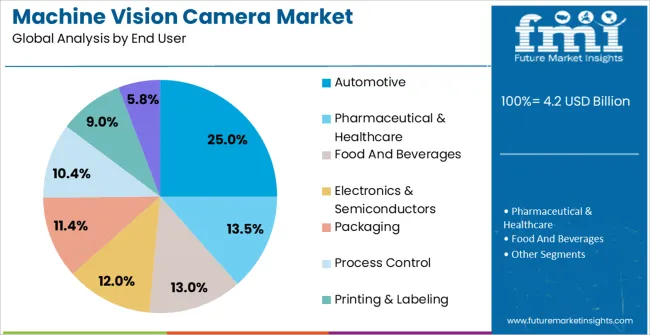
The Automotive end-use industry segment is projected to hold 25.00% of the Machine Vision Camera market revenue in 2025, making it the leading end-user sector. This dominance is being driven by the widespread adoption of machine vision cameras in vehicle manufacturing for applications such as assembly line inspection, component verification, and robotic guidance. The segment has benefited from the industry’s focus on precision, efficiency, and defect-free production, where automated inspection systems significantly reduce human error and enhance throughput.
Growth has also been supported by rising integration of cameras with AI-based vision software to enable real-time monitoring, predictive maintenance, and quality control. As automotive manufacturers continue to invest in smart factories and automation, the need for scalable and upgradeable imaging solutions has increased.
Furthermore, the expansion of electric vehicle production and the adoption of advanced driver assistance systems have further accelerated demand for high-performance cameras Consequently, the Automotive segment is expected to sustain its leadership by leveraging technological advancements and the ongoing transition toward automated and intelligent manufacturing processes.
Numerous camera types are present in the market. Surveillance cameras have varied uses and are not just restricted for monitoring. New technologies are continuously adopted for fast and accurate development of products all around the world.
Systems like machine vision cameras help achieve the same by providing insights about robots, machines, and processes. Machine vision cameras serve as an important component of bigger systems to increase quality, efficiency, and product safety. Machine vision camera systems generate images that are automatically analyzed by software.
These images are then processed by the system through quality tests, control processes, guide machines, codes, and component identification to deliver valuable data for optimizing production.
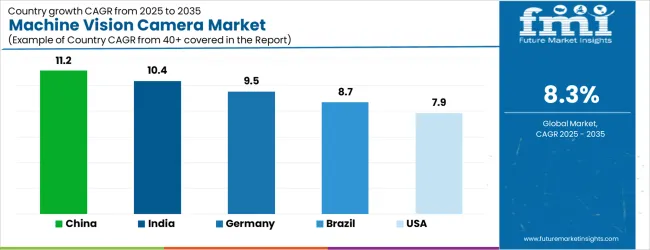
| Country | CAGR |
|---|---|
| China | 11.2% |
| India | 10.4% |
| Germany | 9.5% |
| Brazil | 8.7% |
| USA | 7.9% |
| UK | 7.0% |
| Japan | 6.2% |
The Machine Vision Camera Market is expected to register a CAGR of 8.3% during the forecast period, exhibiting varied country level momentum. China leads with the highest CAGR of 11.2%, followed by India at 10.4%. Developed markets such as Germany, France, and the UK continue to expand steadily, while the USA is likely to grow at consistent rates. Japan posts the lowest CAGR at 6.2%, yet still underscores a broadly positive trajectory for the global Machine Vision Camera Market. In 2024, Germany held a dominant revenue in the Western Europe market and is expected to grow with a CAGR of 9.5%. The USA Machine Vision Camera Market is estimated to be valued at USD 1.5 billion in 2025 and is anticipated to reach a valuation of USD 1.5 billion by 2035. Sales are projected to rise at a CAGR of 0.0% over the forecast period between 2025 and 2035. While Japan and South Korea markets are estimated to be valued at USD 191.5 million and USD 120.7 million respectively in 2025.
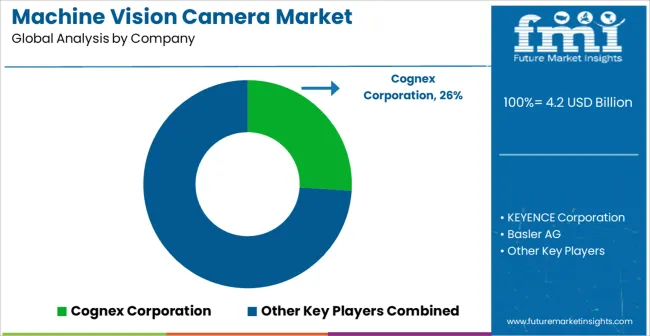
| Item | Value |
|---|---|
| Quantitative Units | USD 4.2 Billion |
| Type | CMOS Sensor-Based Cameras and CCD Sensor-Based Cameras |
| Function | Area Scan Cameras, 3D Cameras, and Line Scan Cameras |
| End User | Automotive, Pharmaceutical & Healthcare, Food And Beverages, Electronics & Semiconductors, Packaging, Process Control, Printing & Labeling, and Others |
| Regions Covered | North America, Europe, Asia-Pacific, Latin America, Middle East & Africa |
| Country Covered | United States, Canada, Germany, France, United Kingdom, China, Japan, India, Brazil, South Africa |
| Key Companies Profiled | Cognex Corporation, KEYENCE Corporation, Basler AG, Teledyne Technologies Inc., Omron Corporation, Allied Vision Technologies GmbH, Adimec Advanced Image Systems, and LMI Technologies, Inc. |
The global machine vision camera market is estimated to be valued at USD 4.2 billion in 2025.
The market size for the machine vision camera market is projected to reach USD 9.2 billion by 2035.
The machine vision camera market is expected to grow at a 8.3% CAGR between 2025 and 2035.
The key product types in machine vision camera market are cmos sensor-based cameras and ccd sensor-based cameras.
In terms of function, area scan cameras segment to command 45.0% share in the machine vision camera market in 2025.






Full Research Suite comprises of:
Market outlook & trends analysis
Interviews & case studies
Strategic recommendations
Vendor profiles & capabilities analysis
5-year forecasts
8 regions and 60+ country-level data splits
Market segment data splits
12 months of continuous data updates
DELIVERED AS:
PDF EXCEL ONLINE
Machine Glazed Paper Market Size and Share Forecast Outlook 2025 to 2035
Machine Tool Oils Market Size and Share Forecast Outlook 2025 to 2035
Machine Glazed Paper Industry Analysis in Western Europe Size and Share Forecast Outlook 2025 to 2035
Machine Glazed Paper Industry Analysis in Korea Size and Share Forecast Outlook 2025 to 2035
Machine Glazed Paper Industry Analysis in Japan Size and Share Forecast Outlook 2025 to 2035
Machine Tool Cooling System Market Analysis - Size, Share, and Forecast Outlook 2025 to 2035
Machine Tool Touch Probe Market Analysis - Size, Growth, and Forecast 2025 to 2035
Machine Mount Market Analysis - Size & Industry Trends 2025 to 2035
Machine Control System Market Growth – Trends & Forecast 2025 to 2035
Machine Automation Controller Market Growth – Trends & Forecast 2025 to 2035
Machine-to-Machine (M2M) Connections Market – IoT & Smart Devices 2025 to 2035
Machine Safety Market Analysis by Component, Industry, and Region Through 2035
Key Players & Market Share in Machine Glazed Paper Industry
Machine Glazed Kraft Paper Market Growth - Demand & Forecast 2024 to 2034
Machine Condition Monitoring Market Insights – Trends & Forecast 2024-2034
Asia Pacific Machine Glazed Paper Market Trends & Forecast 2024-2034
Machine Learning As A Services Market
Machine Vision System And Services Market Size and Share Forecast Outlook 2025 to 2035
Machine Vision Market Insights – Growth & Forecast 2024-2034
BMI Machine Market Size and Share Forecast Outlook 2025 to 2035

Thank you!
You will receive an email from our Business Development Manager. Please be sure to check your SPAM/JUNK folder too.
Chat With
MaRIA